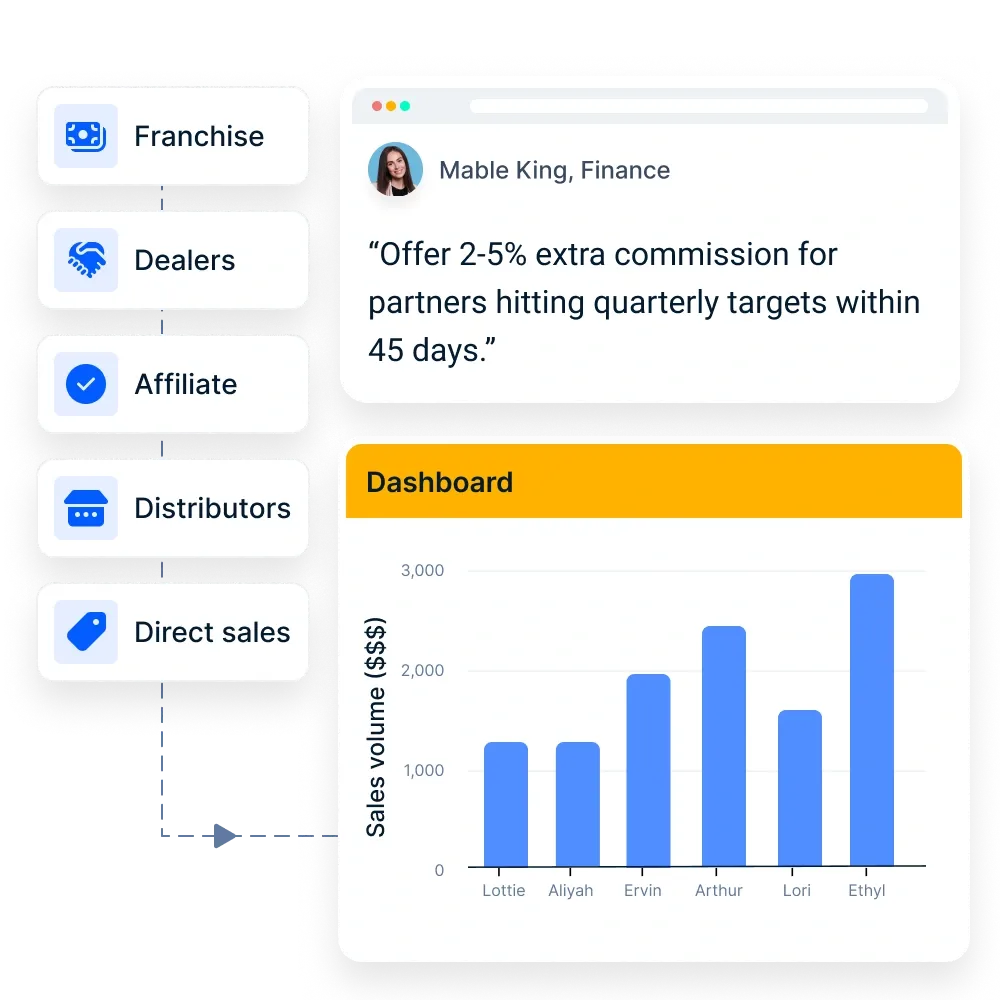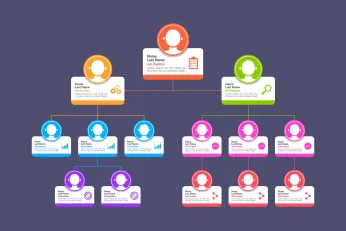5 Channel Partner Management Strategies for Growth and Success
Channel partner management is crucial for businesses to drive revenue growth, increase customer satisfaction, and build strong relationships with partners.
On this page
Channel partner management is the backbone of successful business growth, yet many organizations overlook its potential. With over 70% of companies relying on channel partners to drive revenue, effective management of these relationships is crucial for maximizing performance and achieving strategic goals.
A well-structured channel partner program not only enhances collaboration but also fosters loyalty and innovation, transforming partners into powerful allies.
This blog will delve into essential channel partner management strategies. We’ll explore actionable insights that can elevate your partnerships to new heights.
What is channel partner and how many types of partnerships are there?
Channel partners are third-party vendors or organizations that collaborate with a company to promote and sell its products or services. They play a crucial role in a successful channel partner program by helping businesses reach customers more effectively through various indirect sales channels.
These partnerships can take several forms, each with unique benefits and management strategies. Following are the types of channel partnerships:
Resellers: These partners purchase products from a company and sell them to end customers. They often have established customer bases and can help penetrate new markets quickly.
Distributors: Acting as intermediaries, distributors buy products in bulk from manufacturers and distribute them to retailers or other businesses, thus facilitating wider market access.
Affiliate partners: These partners promote a company's products or services through their marketing channels in exchange for a commission on sales generated. They are particularly effective in lead generation and expanding brand awareness.
Referral partners: These partners refer potential customers to a company, often receiving a fee or commission for successful conversions. They can be instrumental in building channel partner relationships that foster mutual success.
Service providers: Companies that offer complementary services can also be considered channel partners. For instance, a software company might collaborate with IT service firms to provide integrated solutions to customers.
Benefits of having channel partners that magnify the importance of its management
Companies that rely solely on direct sales often struggle to achieve the growth they desire. This is why many brands are turning to channel partnerships. These partnerships involve third-party vendors who can significantly boost sales and marketing efforts in the following way.
- Cost efficiency is one of the primary advantages of engaging with channel partners. You won’t need to hire numerous salespeople. Instead, your channel partners invest their own resources to generate leads and sales, drastically reducing your customer acquisition costs. You only pay for what you get, making it a financially savvy choice.
- Market access is another compelling benefit. Channel partnerships allow companies to penetrate hard-to-reach markets more easily. By leveraging the networks of new partners, businesses can expand their visibility and reach, which is crucial for expanding market reach.
- Increased revenue is a significant outcome of effective channel partner management. Channel sales can lead to substantial revenue growth for your company. By collaborating with the right channel partners, you can enhance your sales strategies and drive more business.
- Additionally, channel partners provide valuable insights into market trends and customer preferences. This information can help refine your channel strategy and align it with your business goals. Regular communication with partners ensures that both parties are on the same page regarding performance metrics and expectations.
Microsoft channel partner management program, known as the Microsoft Cloud Partner Program (MCPP), is designed to support and empower its partners in delivering Microsoft solutions and services to customers.
The program has undergone significant changes in recent years, reflecting the shift towards cloud computing, cybersecurity, and AI technologies.
Microsoft relies heavily on its partner network, with channel partners generating 95% of its commercial revenue.
The company offers various tools and resources to support its partners, including training, marketing support, and deal registration.
Channel partner management offers numerous benefits, including expanded market reach, increased sales, and enhanced customer satisfaction. However, to fully realize these advantages, it’s essential to navigate the challenges that come with managing these partnerships.
5 Challenges in channel partner management
In the dynamic world of business, effective channel partner management is crucial for success. As companies increasingly rely on channel partners to drive sales and expand market reach, understanding the challenges in managing these relationships becomes essential.
1. Communication gaps
One of the biggest hurdles is communication. When there are gaps, misunderstandings arise, leading to misaligned goals. This disconnect can derail sales and marketing efforts, making it hard for both the company and its partners to thrive.
2. Lack of engagement
Engagement is another critical factor. If channel partners don’t feel valued or supported, their productivity may dwindle. Recognizing and rewarding partners fosters a mutually beneficial relationship, encouraging them to put forth their best efforts.
3. Inconsistent reporting
Inconsistent reporting practices can obscure partner performance and ROI. Without standardized metrics, identifying areas for improvement becomes challenging, hindering the overall success of the channel partner program.
4. Inefficient resource allocation
Inefficient resource allocation can waste time and opportunities. Partners need access to the right tools and training materials to effectively manage their sales processes and meet targets.
5. Inadequate training and support
Finally, inadequate training can lead to underperformance. Comprehensive training programs help partners stay updated on products and strategies, ensuring they can effectively market the company’s offerings.
By addressing these challenges head-on, businesses can build stronger channel partnerships that drive mutual success.
IBM channel partner management program is designed to support and empower its partners in various ways despite the challenges.
The program, known as IBM Partner World, is a comprehensive umbrella program that encompasses all IBM partner activities across different business units, segment groups, industry teams, and geographies.
Partners receive marketing resource managers to help plan integrated marketing campaigns.
Additionally, the program includes co-marketing initiatives and IBM Innovation Centers, which provide physical locations for partner education and customer entertainment
However, a well-defined channel partner strategy is essential for overcoming the challenges of channel partner management.
Channel partner management strategies with tips on implementation
Navigating the complexities of channel partner management is crucial for any business aiming for growth. A strategic approach can transform partnerships into a powerful engine for success. Here’s how you can effectively manage channel partners and elevate your channel strategy.
1. Enhance communication
Strategy: Foster open lines of communication with your channel partners.
Implementation: Regular newsletters and updates keep partners informed about the company's products and industry trends. Establish dedicated support channels, like specialized email addresses or chat systems, to demonstrate your commitment to their success. Tools like Slack or Microsoft Teams can facilitate real-time collaboration, ensuring that all partners are aligned and engaged.
Regular updates and dedicated support channels keep partners informed. Compass can streamline this process by providing a centralized platform that facilitates real-time collaboration, ensuring that all partners are aligned and engaged.
2. Boost engagement
Strategy: Create incentive programs to motivate partners.
Implementation: Implement SPIFFs to reward partners for exceeding sales targets or successfully promoting new products. Recognize achievements through awards ceremonies, which not only motivate high performers but also encourage a culture of excellence. Regular feedback sessions help partners feel valued and foster strong partner relationships.
Implement incentive programs to reward partners for exceeding sales targets. Compass’s channel incentive management solution automates incentive calculations and disbursements, ensuring timely and accurate payouts that motivate partners to perform at their best.
3. Standardize reporting
Strategy: Use unified reporting systems for consistent performance tracking.
Implementation: Implement CRM tools like Compass to track partner performance against key performance indicators (KPIs). Standardized reports provide insights into sales volumes and lead generation, enabling fair evaluations and strategic decision-making.
Standardized reports provide insights into partner performance. Compass offers real-time visibility into key performance indicators (KPIs), allowing businesses to track sales progress and optimize their channel strategy effectively.
4. Optimize resource allocation
Strategy: Tailor resources based on partner strengths.
Implementation: Assess each partner's capabilities and market position to provide customized marketing materials and support. This targeted approach maximizes the effectiveness of your investments and enhances partner performance.
5. Improve training and support
Strategy: Offer comprehensive training programs.
Implementation: Develop webinars and online courses covering essential skills and product knowledge. A partner portal with training materials ensures continuous improvement, empowering partners to thrive in new markets. By investing in their growth, you create a win-win situation that drives increased sales and successful partnership management.
Wrapping up with key takeaways:
As we've explored, channel partnerships can significantly enhance your market reach, drive revenue, and foster innovation. However, realizing these benefits requires a proactive approach to managing partner relationships.
By addressing common challenges—such as communication gaps, lack of engagement, and inadequate training—you can create a robust framework that supports both your company and its partners.
- Engaging with channel partners can lead to cost efficiency, increased market access, and significant revenue growth.
- Communication gaps can hinder partner performance; maintaining open lines of communication is crucial.
- Recognizing and rewarding partner engagement fosters a mutually beneficial relationship and enhances productivity.
- Standardized reporting practices are vital for tracking partner performance and optimizing sales strategies.
- Efficient resource allocation ensures partners have the right tools and support to meet their sales targets.
Revolutionize Channel Partner Management with Compass

Build complex and scalable channel incentive plans ten times faster with intuitive no-code plan designer that requires no coding skills. Design and launch personalized channel partner programs tailored to specific criteria, ensuring that each partnership is optimized for success.
By analyzing revenue trends across distributor plans, Compass helps identify profitable distribution networks, giving businesses insights into their most effective channels. Compass supports the execution of short-term tactical schemes and trade promotions, providing a significant competitive advantage in the marketplace.
FAQs
1. What is channel partner management?
Channel partner management involves overseeing and optimizing relationships with third-party vendors or organizations that promote and sell a company's products or services. Effective management is essential for maximizing performance and achieving strategic business goals.
2. What are the 5 steps of the channel management process?
- Partner Recruitment: Identify and onboard potential partners that align with your business goals.
- Partner Enablement: Provide training, resources, and support to help partners effectively sell your products.
- Performance Monitoring: Track partner performance using key performance indicators (KPIs) to assess effectiveness.
- Engagement and Communication: Maintain regular communication to foster strong relationships and address concerns.
- Continuous Improvement: Gather feedback and make adjustments to enhance the partnership and drive mutual success.
3. What is the role of a channel partner manager?
A channel partner manager is responsible for developing and maintaining relationships with channel partners, ensuring they have the necessary resources, training, and support to succeed. They also monitor partner performance, facilitate communication, and strategize ways to optimize the partnership for mutual growth.
4.What is the channel partner management process?
The channel partner management process encompasses recruiting partners, enabling them with training and resources, monitoring their performance, engaging in ongoing communication, and continuously improving the partnership based on feedback and performance metrics.
5. What is channel relationship management?
Channel relationship management focuses on building and maintaining strong relationships with channel partners. It involves effective communication, engagement strategies, and support systems that foster collaboration and drive mutual success in sales efforts.
6.What is channel partner management? (Reiterated)
Channel partner management is the strategic approach to managing relationships with third-party vendors or organizations that help promote and sell a company’s products or services, aiming to maximize performance, drive revenue growth, and achieve business objectives.












